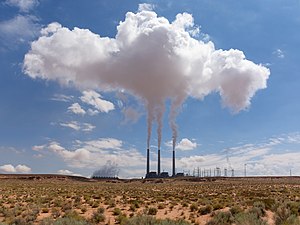
The Clean Power Plan was an Obama administration policy aimed at combating climate change that was first proposed by the Environmental Protection Agency (EPA) in June 2014.[1] The final version of the plan was unveiled by President Barack Obama on August 3, 2015.[2] Each state was assigned a target for reducing carbon emissions within its borders, which could be accomplished how the states saw fit, but with the possibility of the EPA stepping in if a state refused to submit a plan.[3] If every state met its target, the plan was projected to reduce carbon emissions from electricity generation by 32 percent relative to 2005 levels by 2030, and would have reduced other harmful air pollution as well.[4]
In March 2017, President Donald Trump signed an executive order mandating that the EPA review the plan.[5][6][7] In June 2017, he withdrew the U.S. from the Paris Climate Agreement, and on October 9, Trump-appointed EPA administrator Scott Pruitt announced the formal process to repeal the Clean Power Plan would begin on October 10, 2017.[8]
In May 2019, EPA Administrator Andrew Wheeler announced plans to change the way the EPA calculates health risks of air pollution, saying the change was intended to rectify inconsistencies in the current cost-benefit analyses used by the agency. This became the Affordable Clean Energy rule.[9] On June 19, 2019, the EPA issued the final Affordable Clean Energy rule (ACE), which replaced the Clean Power Plan. On January 19, 2021, the last full day of the Trump administration, the D.C. Circuit vacated the Affordable Clean Energy rule and remanded to the EPA for further proceedings consistent with its opinion. The court characterized the ACE as a "fundamental misconstruction" of environmental laws. The ruling did not reinstate the Clean Power Plan; however, it did create the opportunity for the Biden administration to improve and clarify the rules.[10][11]
In 2022, in the case West Virginia v. EPA, the U.S. Supreme Court curbed the EPA's ability to broadly regulate carbon emissions from existing power plants as was done in the Clean Power Plan. The Clean Power Plan was no longer in place, but if it had been, the ruling would have struck it down.[12]
In 2024, the Biden Administration issued a suite of rules called the Greenhouse Gas Standards and Guidelines for Fossil Fuel-Fired Power Plants, sometimes called the "Clean Power Plan 2.0", to replace the Clean Power Plan and ACE.[13]
- ^ "Clean Power Plan for Existing Power Plants". EPA. Archived from the original on March 25, 2016. Retrieved August 14, 2018.
- ^ "Climate change: Obama unveils Clean Power Plan". BBC News. August 3, 2015. Retrieved August 3, 2015.
- ^ Plumer, Brad (August 4, 2015). "How Obama's Clean Power Plan actually works — a step-by-step guide". Vox.
- ^ Cite error: The named reference
telegraph1was invoked but never defined (see the help page). - ^ Davenport, Coral (March 21, 2017). "Trump Lays Plans to Reverse Obama's Climate Change Legacy". The New York Times.
- ^ Davenport, Coral (March 28, 2017). "Trump Signs Executive Order Unwinding Obama Climate Policies". The New York Times.
- ^ "Federal Court Extends Suspension Of Clean Power Plan Case". Solar Industry. August 9, 2017. Archived from the original on August 11, 2017. Retrieved August 11, 2017.
- ^ Multiple sources:
- Manchester, Julia (October 4, 2017). "EPA to propose ending Obama-era Clean Power Plan: report". The Hill.
- Dennis, Brady; Eilperin, Juliet (October 6, 2017). "Trump administration will propose repealing Obama's key effort to combat climate change". The Washington Post.
- Dlouhy, Jennifer A (October 6, 2017). "Trump Is Seen Replacing Obama's Power Plant Overhaul With a Tune-Up". Bloomberg.
- "U.S. to 'Withdraw' Obama-Era Clean Power Plan Tuesday, EPA Head Says". The Weather Channel. Associated Press. October 9, 2017. Archived from the original on October 12, 2017. Retrieved October 9, 2017.
- Friedman, Lisa; Plumer, Brad (October 9, 2017). "E.P.A. Announces Repeal of Major Obama-Era Carbon Emissions Rule". The New York Times.
- I.K. (October 10, 2017). "Scott Pruitt signs a measure to repeal the Clean Power Plan". The Economist.
- "Pruitt signs rule undoing Clean Power Plan". MercuryNews.com. October 10, 2017. Retrieved October 15, 2017.
- "Pruitt signs proposal to withdraw from Obama-era Clean Power Plan". TheWeek.com. Retrieved October 15, 2017.
- ^ Green, Miranda (May 21, 2019). "EPA to reconsider cost benefit analysis of air pollution on human life". The Hill. Retrieved May 25, 2019.
- ^ Friedman, Lisa (January 19, 2021). "Court Voids a 'Tortured' Trump Climate Rollback". The New York Times.
- ^ "EPA's Industry-Friendly Climate Rule Struck Down by Court (3)". news.bloomberglaw.com.
- ^ de Vouge, Ariane; Nilson, Ella; Stracqualursi, Veronica (June 30, 2022). "Supreme Court curbs EPA's ability to fight climate change". Retrieved August 14, 2024.
- ^ "Greenhouse Gas Standards and Guidelines for Fossil Fuel-Fired Power Plants". EPA.gov. April 25, 2023. Retrieved August 14, 2024.